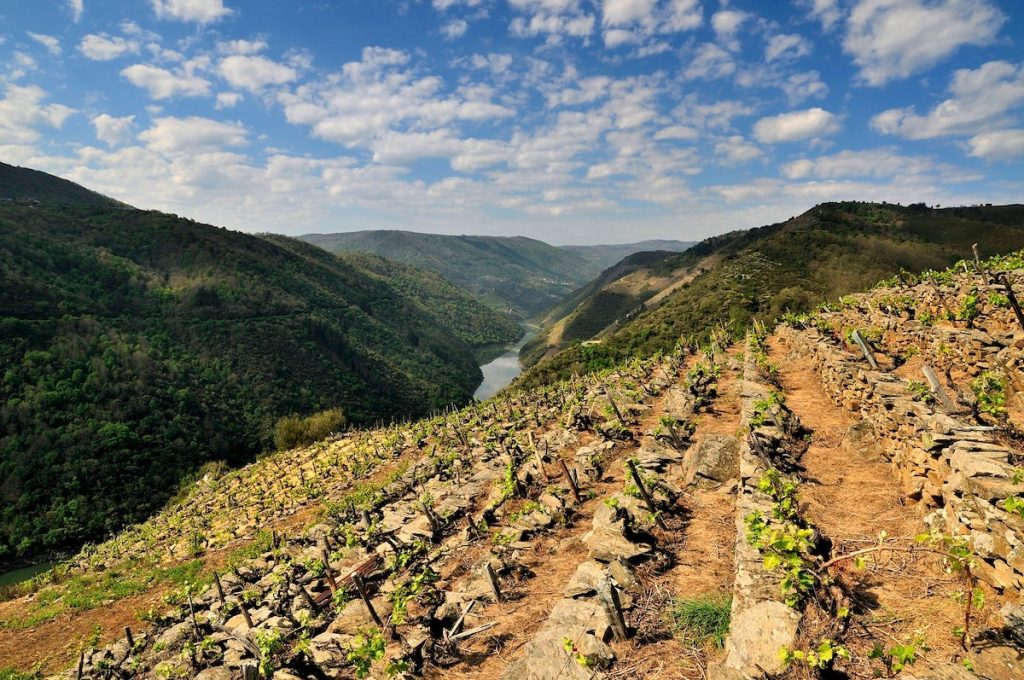Some of Europe’s Most Popular Wines at Risk From Climate Crisis
3 min read
Viticulture wine production in Ribeira Sacra, Spain, dates back to Roman times. Chencho Mendoza Photography / Moment Open / Getty Images
Founded in 2005 as an Ohio-based environmental newspaper, EcoWatch is a digital platform dedicated to publishing quality, science-based content on environmental issues, causes, and solutions.
Some of the most breathtaking and specialized wine regions in the world are also the most challenging to maintain.
Vineyards in these areas are part of what is known as “heroic viticulture,” meaning the grapes are grown in extreme environments, such as altitudes of 1,640 feet or more above sea level, on slopes of 30 percent or higher grade, on small islands or on terraces, reported Cell Press.
They are referred to as “heroic” because the grapes there are difficult to cultivate and harvest.
“Viticulture becomes ‘heroic’ when practiced under extreme climatic, geomorphologic, and geographical conditions. Farmers are considered heroes because they deal with this ‘adverse’ environment every day, typically by purely manual operations without the use of mechanized tools,” researchers from the University of Padova wrote in a Backstory published in the journal iScience.
In addition to the inherent challenges of cultivating wine grapes in these regions, scientists are now concerned that extreme weather brought on by climate change, as well as shifting socioeconomic conditions, may present risks to crops and their cultural legacy, according to Cell Press.
“The risk is not only losing an agricultural product or seeing a landscape change, negatively impacting the local economy,” the authors of the Backstory wrote. “The risk is losing entire communities’ history and their cultural roots.”
Some of the world’s most celebrated wines come from the heroic viticulture regions of Portugal, Spain and Italy, including the Prosecco Hills, Cell Press reported.
“Viticulture is one of the most relevant agricultural systems of steep-slope landscapes. In Europe, we can find some of the most famous sites and popular wines (e.g., Port wine, Prosecco, Passito),” the authors wrote. “Landscapes characterized by heroic viticulture have been recognized and protected by the United Nations, being inserted in the United Nations Educational, Scientific and Cultural Organization (UNESCO) World Heritage Sites and the Food and Agriculture Organization (FAO) Globally Important Agricultural Heritage Systems (GIAHS). Here, a virtuous combination of agronomic practice, famous wine, networks of restaurants, green tourism, and even religion and art (if churches are on the site) created an optimal condition for a circular economy and socioeconomic sustainability. Nevertheless, these landscapes are under threat [from the] changing climate.”
These rare wines come under a multitude of climate-related threats, as the authors highlight in the Backstory.
“The increased frequency of weather extremes driven by climate change accelerates soil degradation. Intense and localized rainfall events, if soil and water conservation solutions are not optimally adopted, can quickly trigger slope failures and widespread soil erosion processes on cultivated hillslopes. In addition, prolonged droughts, as we observed in Europe in 2022, could pose another criticality: sustainable water resources management on steep slopes,” the authors wrote.
The authors went on to say that socioeconomic factors pose additional issues for the survival of heroic vineyards.
“The last half past century has been characterized by rural exodus and a gradual abandonment of mountain landscapes. The new generation is unwilling to continue working under extreme conditions if economic benefits are insignificant.”
Solutions such as small water storage systems that prevent runoff, as well as discussions and collaboration between farmers, scientists and consumers were suggested by the authors, reported Cell Press.
“The key to success lies in combining the traditional knowledge of winemakers with innovation and scientific rigor,” the authors of the Backstory wrote. “In this way, farms can work closely with scientists to optimize investments for a more functional, sustainable, and safe agricultural landscape — a winning alliance to face these diverse natural and anthropogenic challenges.”
Subscribe to get exclusive updates in our daily newsletter!
By signing up, you agree to the Terms of Use and Privacy Policy & to receive electronic communications from EcoWatch Media Group, which may include marketing promotions, advertisements and sponsored content.





